AUDI Q3 2016 Owners Manual
Manufacturer: AUDI, Model Year: 2016, Model line: Q3, Model: AUDI Q3 2016Pages: 252, PDF Size: 62.81 MB
Page 131 of 252
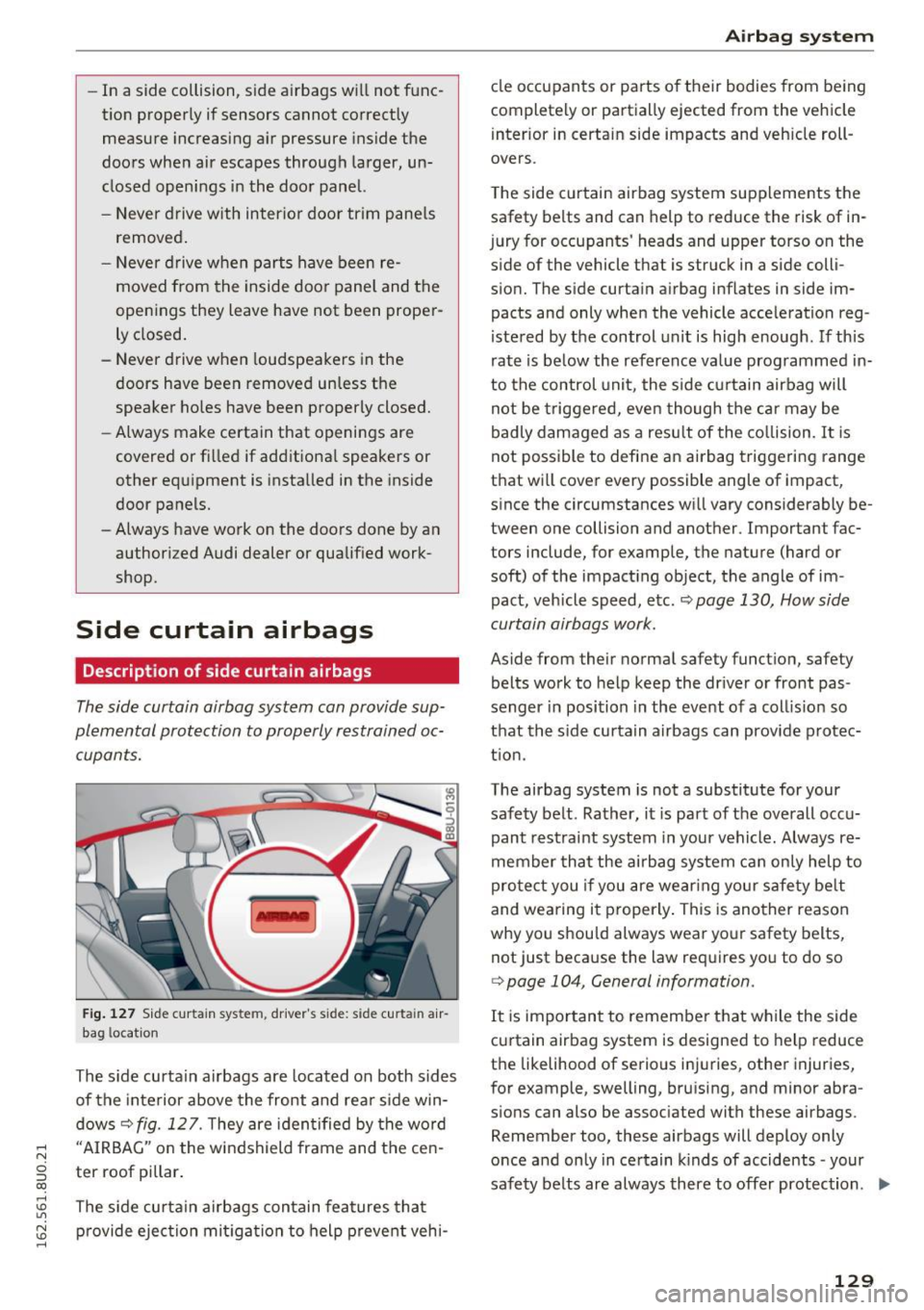
.... N
c:i ::J CX)
.... I.Cl U"I
N I.Cl ......
-In a side collision, side airbags will not func
tion properly if sensors cannot correctly
measure increasing a ir pressure inside the
doors when air escapes through larger, un
closed openings in the door panel.
- Never drive w ith inter ior door trim pane ls
removed.
- Never drive when parts have been re
moved from the inside door panel and the
openings they leave have not been proper ly closed.
- Never drive when loudspeakers in the doors have been removed un less the
speaker holes have been properly closed.
- Always make certain that openings are
covered or fi lled if additional speakers or
other eq uipment is installed in the inside
door panels.
- Always have work on the doors done by an
author ized Audi dealer or qualif ied work
shop.
Side curtain airbags
Description of side curtain airbags
The side curtain airbag system can provide sup
plemental protection to properly restrained oc
cupants.
F ig . 127 S ide curtain sys te m , dr iver's side: s ide c urta in air
bag locat ion
The s ide curtain airbags are located on both sides
of the interior above the front and rear s ide win
dows
Q fig. 127 . They are iden tified by the wo rd
"AIRBAG" on the w indshield frame and the ce n
ter roof pillar.
The s ide curta in airbags contain features that
p rovide ejec tion mi tiga tion to help p reve nt veh i-
Airb ag sys tem
cle occupants or par ts of their bodies from being
completely or partially ejected from the vehicle
i nterior in certain side impacts and veh icle roll
overs .
T he side curtain airbag system supplements the
safety belts and can help to reduce the risk of in
j ury for occupants' heads and upper torso on the
s ide of the vehicle that is struck in a side colli
sion. The s ide curtain airbag inflates in side im
pacts and only when the vehicle acce leration reg
istered by t he control unit is high enough . If this
rate is be low the reference va lue programmed in
to the control unit, the side cu rtain airbag will
not be t riggered, even though the ca r may be
badly damaged as a resu lt of the co llision . It is
not possible to define an airbag triggering range
that wi ll cover every possible angle of impact,
s ince the circumstances will vary considerably be
tween one collision and another. Important fac
tors include, for example, the nature (hard or
soft) of the impact ing object, the angle of im
pact, vehicle speed, etc .
Q page 130, How side
curtain airbags work.
Aside from their normal safety funct ion, safety
belts work to help keep the drive r or front pas
senger in position in the event of a coll is ion so
that the s ide curtain a irbags can prov ide p rotec
t ion.
The airbag system is not a substit ute for your
safety belt. Rather, it is part of the overall occ u
pant restraint system in your vehicle. Always re
member tha t the ai rbag system can on ly help to
pro tec t you if you are wear ing you r sa fety be lt
and wearing it properly . This is another reason
why you shou ld always wear yo ur safety belts,
not just because the law req uires you to do so
Q page 104, General information.
It is important to remember that while the side
cu rtain airbag system is designed to help reduce
the likelihood of serio us injuries, other injuries,
for example, swelling, bru ising, and minor abra
s ions can also be assoc iated with these airbags .
Remember too, these airbags will deploy only
once and on ly in ce rtain k inds of accidents -your
safety belts are always there to offer protec tion. ..,.
129
Page 132 of 252
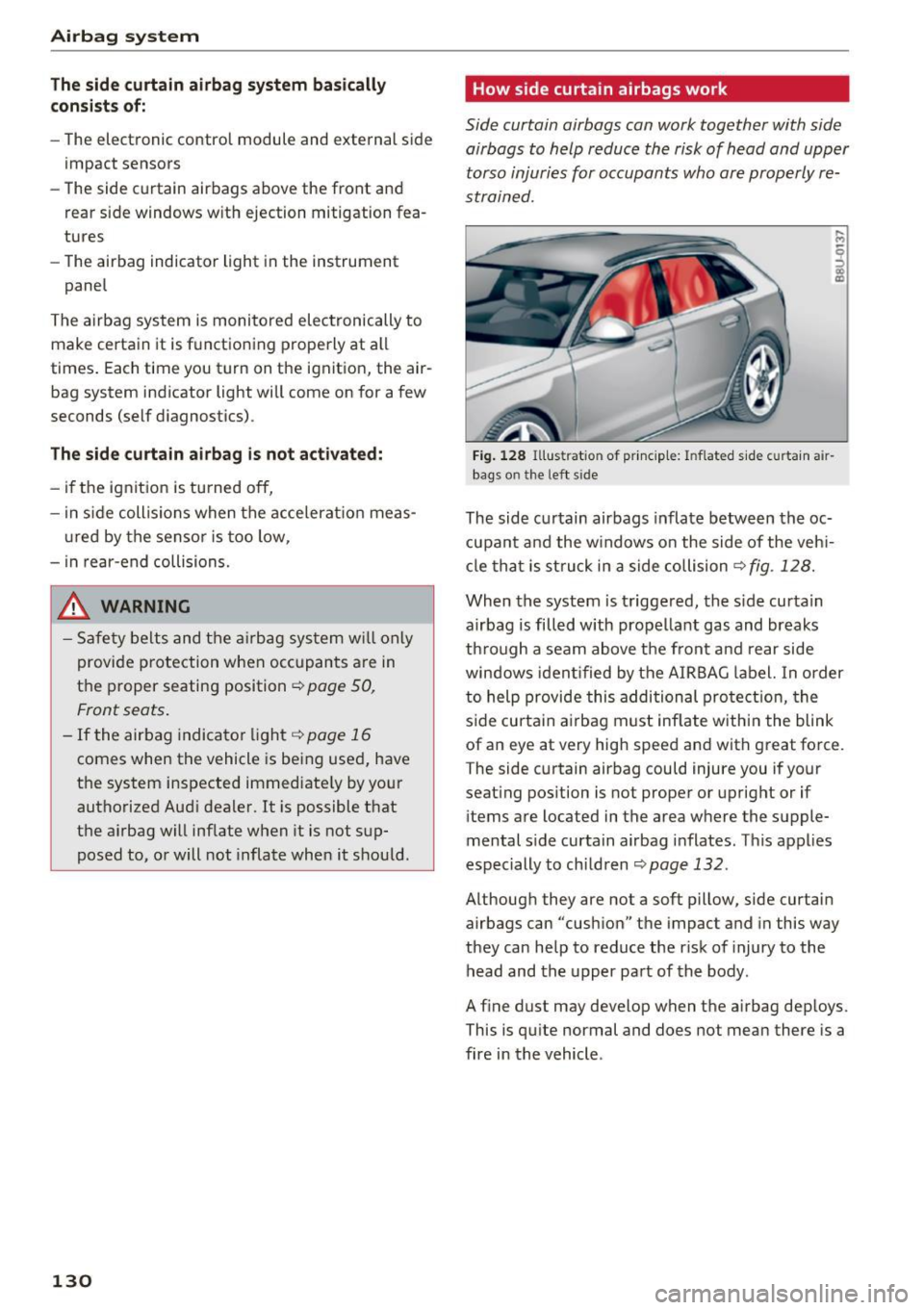
Airbag system
The side curtain airbag system basically
consists of:
- The electronic control module and external side
impact sensors
- The side curta in airbags above the front and
rear side windows with ejection mitigation fea
tures
- The airbag indicator light in the instrument
panel
The airbag system is monitored electronically to
make certain it is functioning properly at all
times. Each time you turn on the ignition, the air
bag system indicator light will come on for a few
seconds (self diagnostics).
The side curtain airbag is not activated:
-if the ignition is turned off,
-in side collisions when the acceleration meas-
ured by the sensor is too low,
- in rear-end collisions.
,&. WARNING
-Safety belts and the airbag system will only
provide protection when occupants are in
the proper seating position
¢ page 50,
Front seats.
-If the airbag indicator light ¢page 16
comes when the vehicle is being used, have
the system inspected immediately by your
authorized Audi dealer . It is possible that
the airbag will inflate when it is not sup
posed to, or will not inflate when it should.
130
How side curtain airbags work
Side curtain airbags can work together with side
airbags to help reduce the risk of head and upper
torso injuries for occupants who are properly re
strained.
Fig. 128 Illus tratio n of principle: I nflated side curtain a ir
bag s on t he left s ide
The side curtain airbags inflate between the oc
cupant and the windows on the side of the vehi
cle that is struck in a side collision
~ fig. 128.
When the system is triggered, the side curtain
airbag is filled with propellant gas and breaks
through a seam above the front and rear side
windows identified by the AIRBAG label. In order
to help provide this additional protection, the
side curtain airbag must inflate within the blink
of an eye at very high speed and with great force.
The side curtain airbag could injure you if your
seating position is not proper or upright or if
items are located in the area where the supple
mental side curtain airbag inflates. This applies
especially to children~
page 132.
Although they are not a soft pillow, side curtain
airbags can "cushion" the impact and in this way
they can help to reduce the risk of injury to the
head and the upper part of the body.
A fine dust may develop when the airbag deploys .
This is quite normal and does not mean there is a
fire in the vehicle .
Page 133 of 252
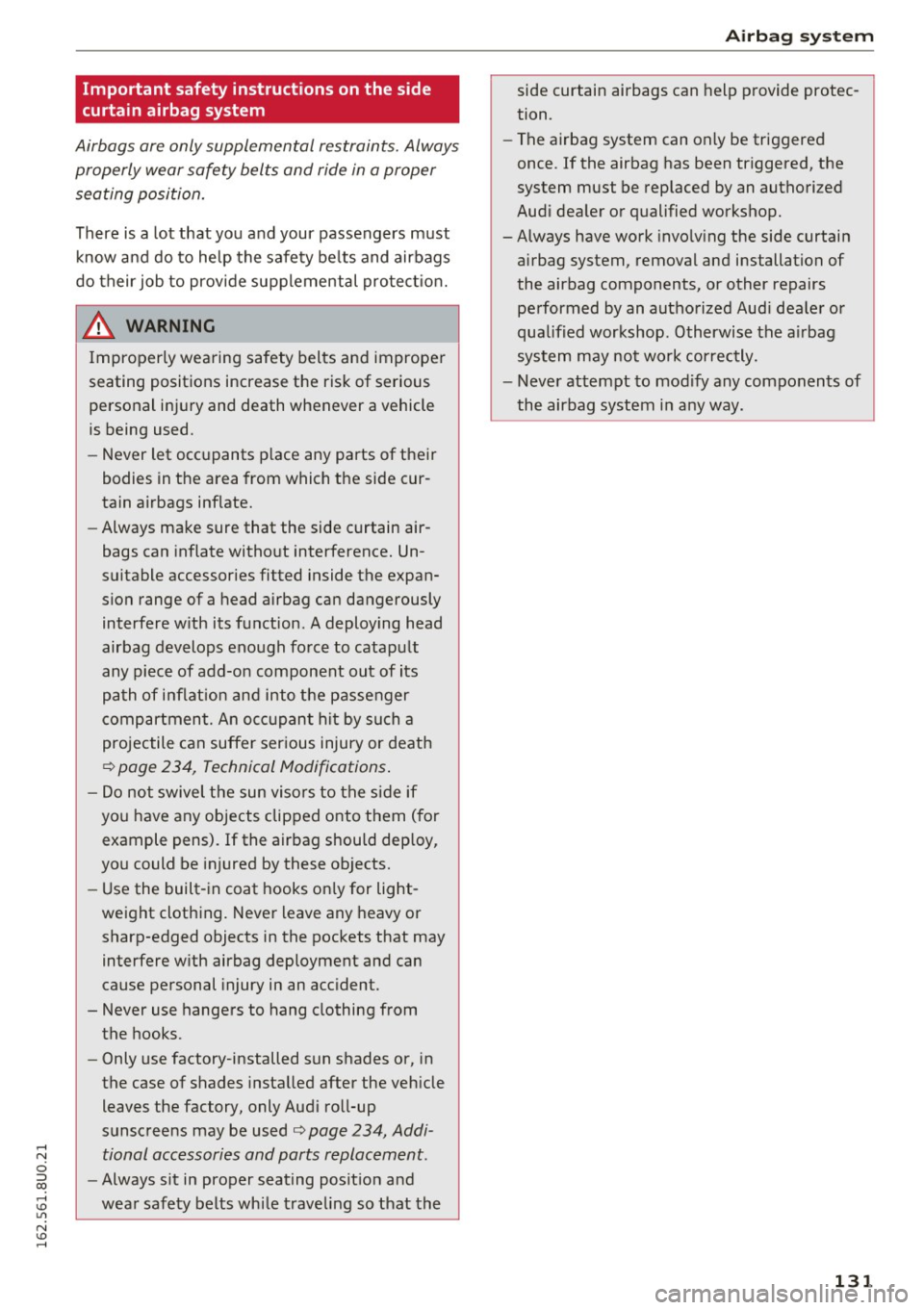
Important safety instructions on the side
curtain airbag system
Airbags are only supplemental restraints. Always
properly wear safety belts and ride in a proper
seating position.
There is a lot that you and your passengers must
know and do to help the safety belts and airbags
do their job to provide supplemental protection.
_& WARNING
-
Improperly wearing safety belts and improper
seating positions increase the risk of serious
personal injury and death whenever a vehicle
is being used.
- Never let occupants place any parts of their
bodies in the area from which the side cur
tain airbags inflate.
- Always make sure that the side curtain air
bags can inflate without interference. Un
suitable accessories fitted inside the expan
sion range of a head airbag can dangerously
interfere with its function. A deploying head
airbag develops enough force to catapult
any piece of add-on component out of its
path of inflation and into the passenger
compartment. An occupant hit by such a
projectile can suffer serious injury or death
¢ page 234, Technical Modifications.
- Do not swivel the sun visors to the side if
you have any objects clipped onto them (for
example pens). If the airbag should deploy,
you could be injured by these objects.
- Use the built-in coat hooks only for light
weight clothing. Never leave any heavy or
sharp-edged objects in the pockets that may
interfere with airbag deployment and can
cause personal injury in an accident.
- Never use hangers to hang clothing from the hooks.
- Only use factory-installed sun shades or, in
the case of shades installed after the vehicle
leaves the factory, only Audi roll-up
sunscreens may be used
¢ page 234, Addi
tional accessories and parts replacement.
- Always sit in proper seating position and
wear safety belts while traveling so that the
Airbag system
side curtain airbags can help provide protec
tion.
- The airbag system can only be triggered
once. If the airbag has been triggered, the
system must be replaced by an authorized
Audi dealer or qualified workshop.
-Always have work involving the side curtain
airbag system, removal and installation of
the airbag components, or other repairs performed by an authorized Audi dealer or
qualified workshop. Otherwise the airbag
system may not work correctly.
- Never attempt to modify any components of
the airbag system in any way.
131
Page 134 of 252
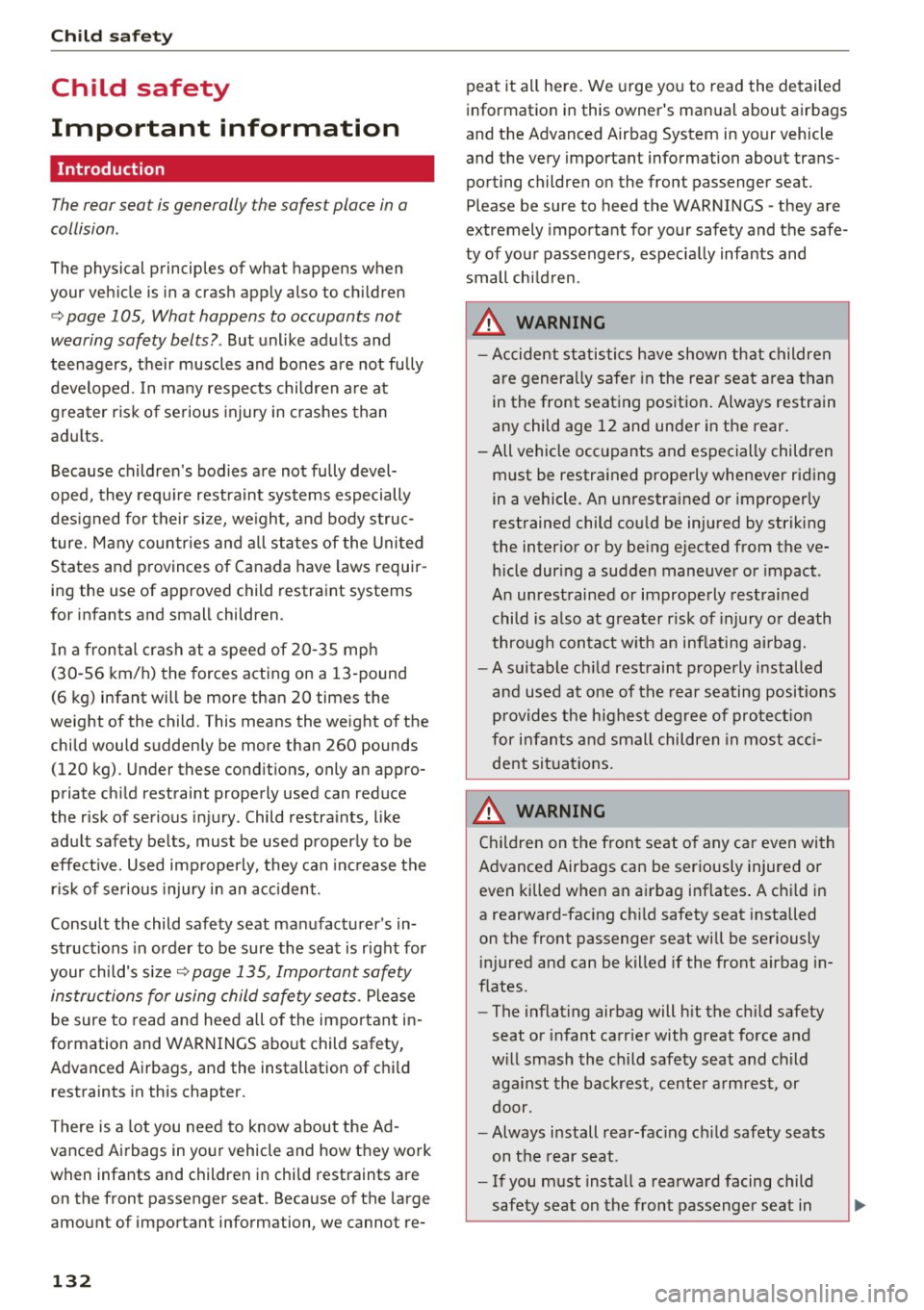
Child safety
Child safety
Important information
Introduction
The rear seat is generally the safest place in a
collision .
The physical principles of what happens when
your vehicle is in a crash apply also to children
¢ page 105, What happens to occupants not
wearing safety belts? .
But unlike adults and
teenagers, their muscles and bones are not fully
developed. In many respects children are at
g reater r isk of serious injury in crashes than
adults .
Because children's bodies are not fully devel
oped, they require restraint systems especially
des igned for their size, weight, and body struc
ture. Many countries and all states of the United
States and provinces of Canada have laws requir
ing the use of approved child restraint systems
for infants and small children .
I n a frontal crash at a speed of 20-35 mph
(30-56 km/h) the forces acting on a 13 -pound
(6 kg) infant will be more than 20 times the
weight of the child. This means the weight of the child would suddenly be more than 260 pounds (120 kg) . Under these conditions, only an appro
priate child restraint properly used can reduce
the risk of serious injury . Child restra ints, like
adu lt safety belts, must be used properly to be
effect ive. Used improperly, they can increase the
risk of serious injury in an acc ident.
Consult the child safety seat manufacturer's in
structions in order to be sure the seat is right for
your child's size¢
page 135, Important safety
instructions for using child safety seats .
Please
be sure to read and heed all of the impo rtant in
formation and WARNINGS about child safety,
Advanced Airbags, and the installation of child
restraints in this chapter.
There is a lot you need to know about the Ad
vanced Airbags in your vehicle and how they work
when infants and children in child restraints are
on the front passenger seat . Because of the large
amount of important information, we cannot re-
132
peat it all here. We urge you to read the detailed
information in this owner's manual about airbags
and the Advanced Airbag System in your vehicle and the very important information about trans
porting children on the front passenger seat.
Please be sure to heed the WARNINGS - they are
extremely importa nt for your safety and the safe
ty of your passengers, especia lly infants and
small chi ldren.
.&_ WARNING
- Accident statistics have shown that children
are generally safer in the rear seat area than
in the front seating position. Always restrain
any child age 12 and under in the rear.
- All vehicle occupants and especially children
must be restrained properly whenever riding
in a vehicle. An unrestrained or improperly
restrained child cou ld be injured by striking
the inter ior or by being ejected from the ve
hicle during a sudden maneuver or impact.
An unrestrained or improperly restrained
child is a lso at greater r isk of injury or death
through contact w ith an inf lating airbag.
- A suitable ch ild restraint properly installed
and used at one of the rear seating positions
provides the highest degree of pro tect ion
for infants and small children in most acci
dent sit uations.
.&_ WARNING
Children on the front seat of any car even with
Advanced Airbags can be seriously injured or
even killed when an airbag inflates. A child in
a rearward-facing chi ld safety seat installed
on the front passenger seat will be seriously injured and can be killed if the front airbag in
flates.
- The inflating airbag will hit the child safety
seat or infant carr ier with great force and
w ill smash the child safety seat and child
aga inst the backrest , center armrest, or
door.
- Always install rear-facing child safety seats
on the rear seat.
- If you must install a rearward facing child
safety seat on the front passenger seat in
Page 135 of 252
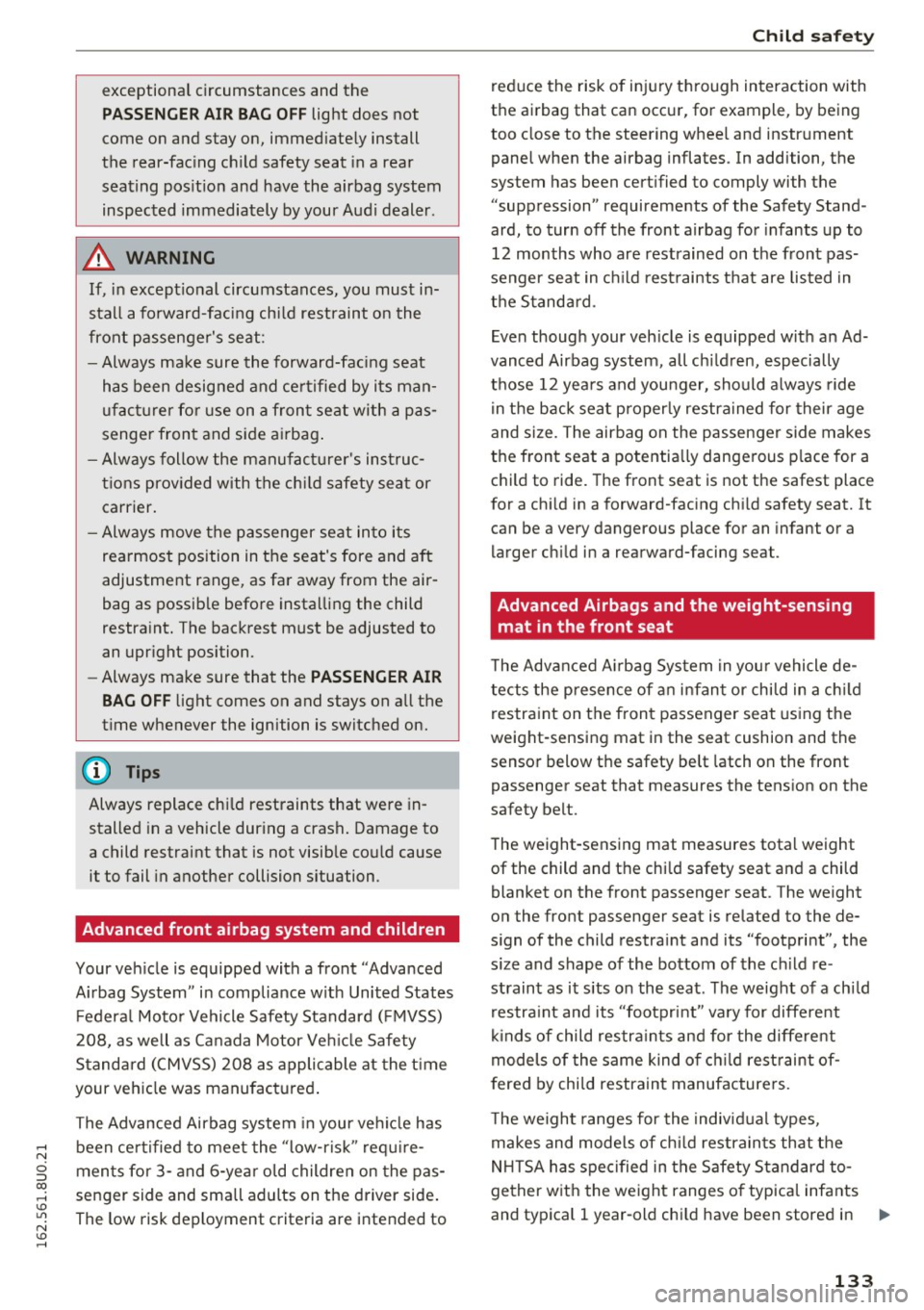
exceptional circumstances and the
PASS ENGER AIR BAG OFF light does not
come on and stay on, immed iately install
the rear-fac ing ch ild safety seat in a rear
seating pos it ion and have the airbag system
inspected immediately by your Audi dealer .
A WARNING
If, in exceptio nal circumstances, you must in
stall a forward-facing chi ld restraint on the
front passenger's seat:
- Always make sure the forward-fac ing seat
has been designed and ce rtified by its man
ufact urer fo r use on a front seat with a pas
senger front and side airbag .
- Always follow the manufact urer's instruc
tions prov ided with the ch ild safety seat or
carrier.
- Always move the passenger seat into its
rearmost position in the seat's fore and aft
adjustment range, as far away from the air
bag as possib le before installing the child
restraint. The backrest must be adjusted to
an upr ight position.
- Always make sure that the
PA SSENGER AIR
BAG OFF
light comes on and stays on all the
t ime whenever the ignition is switched on.
{D) Tips
Always replace chi ld restraints that were in
stalled in a vehicle dur ing a crash . Damage to
a child restraint that is not visible could cause
it to fail in another collision situation.
Advanced front airbag system and children
Your veh icle is equipped with a front "Advanced
Airbag System " in compliance w ith United States
F edera l Moto r Vehicle Safety Standard (FMVSS)
208, as well as Canada Motor Ve hicle Safe ty
Stand ard (CMVSS) 208 as appli cable at the t ime
your vehicle was manufactured .
The Advanced Airbag system in your ve hicle has
been ce rtified to meet the "low-risk " requ ire
ments for 3 -and 6-year old children on the pas
senger side and small adults on the driver side .
The low risk deployment criteria are intended to
Ch ild safety
reduce the risk of injury through interaction with
the airbag that can occur, for example, by being
too close to the steering wheel and instr ument
panel when the airbag inflates. In addition, the
system has been cert ified to comply with the
"suppression" requirements of the Safety Stand
ard, to turn off the front airbag for infants up to
12 months who are restrained on the front pas
senger seat in ch ild rest raints that are lis ted in
the S tanda rd .
Even thoug h your veh icle is equipped with an Ad
vanced Airbag system, all ch ildren, especially
those 12 yea rs and younger, sho uld a lways ride
i n the back seat properly restra ined for their age
and size . The airbag on the passenger side makes
the front seat a potentia lly dangerous p lace for a
child to ride. The front seat is not the safest place
for a ch ild in a forward-fac ing ch ild safety seat. It
can be a very dangerous place for an infant or a
larger ch ild in a rearward-facing seat .
Advanced Airbags and the weight -sensing
mat in the front seat
T he Advanced A irbag System in you r vehicle de
tects the presence of a n in fan t or child in a ch ild
restra int on the front passenger seat using the
weight-sensing mat in the seat cushion and the sensor below the safety belt latch on the front
passenger seat that measures the tension on the
safety belt.
The weight-sensing mat measures total weight
of the child and the chi ld safety seat and a child
blanket on the front passenger seat. The weight
on the front passenger seat is related to the de
s ign of the child restra int and its "footprint" , the
s ize and shape of the bottom of the c hild re
straint as it s its on the seat. The weight of a chi ld
r estra int and its "footprint " va ry for different
k inds of child restra ints and for the different
models of the same kind of ch ild rest raint of
fered by child restraint manufacturers.
T he weight ranges for the individ ual types,
makes and mode ls of chi ld restrain ts that the
N HT SA has spec ified in the Safety Standard to
gether with the weight ranges o f typical infants
and typical 1 year-old chi ld have been stored in .,.
133
Page 136 of 252
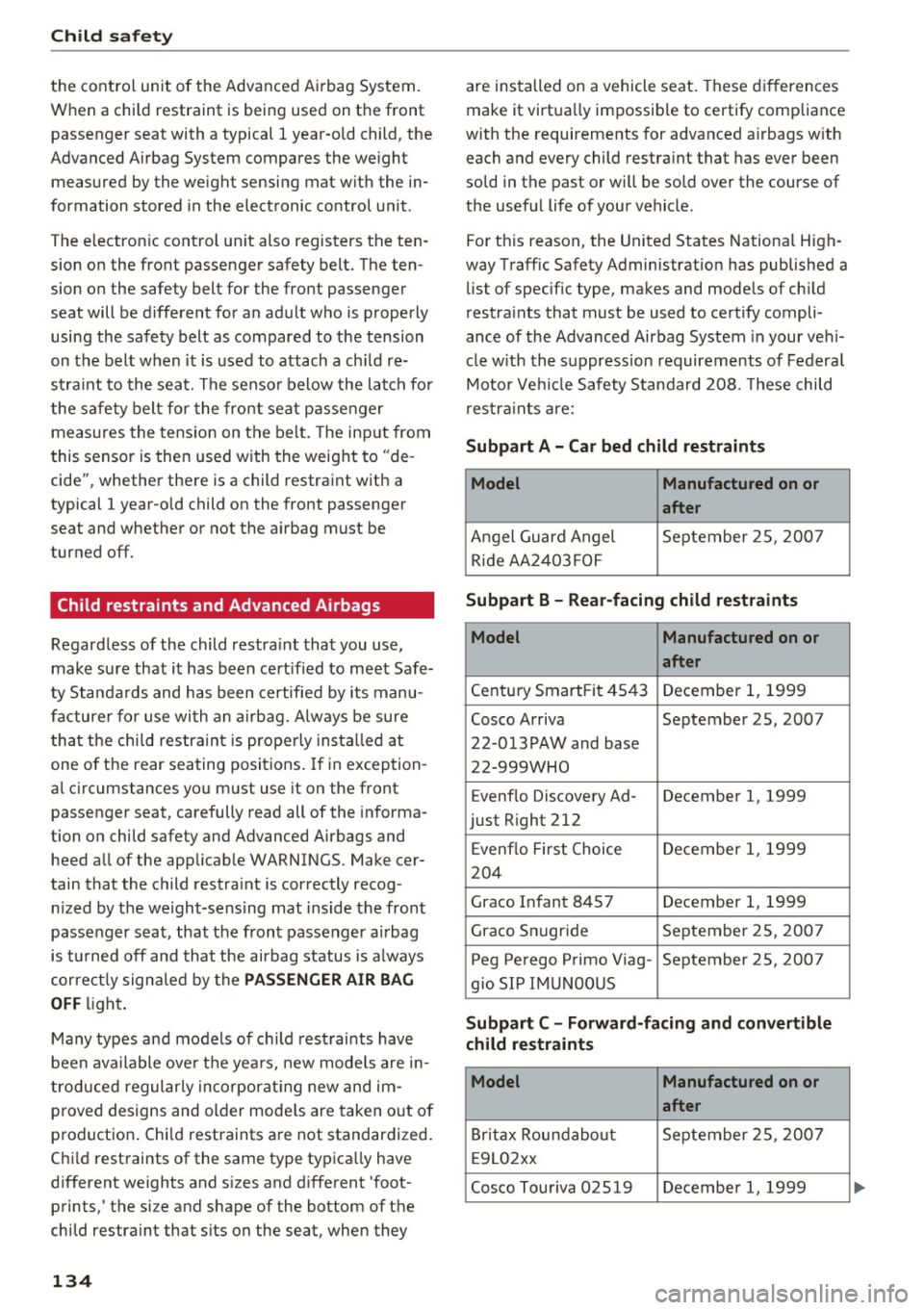
Child safet y
the control unit of the Advanced Ai rbag System.
When a chi ld restraint is being used on the front
passenger seat with a typical 1 year-old child, the
Advanced Airbag System compares the we ight
measured by the weight sensing mat with the in
formation stored in the electronic control unit.
The electronic cont rol un it also registers the ten
sion on the front passenger safety belt. The ten
sion on the safety belt for the front passenger
seat will be d ifferent fo r an adult who is properly
using the safety belt as compared to the tension
on the belt when it is used to attach a ch ild re
stra int to the seat. The senso r below the la tch fo r
the safety belt for the fro nt sea t passe nger
meas ures the tens io n on the belt. The inp ut from
this sensor is then used with the weight to "de
cide", whether there is a child restraint with a
typical 1 year-old child on the front passenger
seat and whethe r or not the a irbag must be
turned off.
Child restraints and Advanced Airbags
Regardless of the child restra int tha t you use,
make sure that it has been cert ified to meet Safe
ty Standa rds and has been certified by its manu
facturer for u se wi th an a irb ag. Always be sure
t ha t th e chi ld res tra in t i s properly insta lled at
one o f th e rear seating posit ions . If i n excep tion
a l ci rcumstances yo u must use it on the front
passenger seat, carefully read all of the informa
tion on child safety and Advanced Airbags and heed a ll of the app licab le WARNINGS. Make cer
tain that the child restra int is correctly recog
n ized by the we ight-sens ing mat inside the front
passenger seat, that t he fron t passenger a irbag
is tu rned off and tha t the airbag status is a lways
cor rect ly signa led by the
PASSENGER AIR BAG
OFF ligh t.
M any types and models of c hild rest rai nts have
been available ove r th e yea rs, new models are in
t roduced regularly incorporat ing new and im
p roved designs and o lder mode ls are taken o ut o f
p roduction . Chi ld restraints a re not standardized .
Ch ild rest raints of the same type typica lly have
d ifferent weights and s izes and d ifferent 'foot
prints, ' the size and shape of the bottom of the
chi ld restraint that s its on the seat, when they
134 are ins
talled on a vehicle seat . These d ifferences
make it virtua lly impossib le to certify compliance
with the requirements for advanced a irbags w ith
each and every child restra int that has eve r been
sold in the past or will be so ld over the course of
the usefu l life of your vehicle.
Fo r thi s reason, the United States Nationa l H igh
way Traffic Safety Administration has published a li st of specific type, makes and mode ls of ch ild
r estra ints that must be used to certify compli
ance of the Advanced Airbag System in your ve hi
cle w ith the s uppress ion requirements of Federa l
Motor Ve hicl e Safety Standa rd 208. These child
r es trai nts are:
Subpart A - Car bed child restraints
Model Manufactured on or
after
Angel Guard Angel Septe mber 25, 2 007
R ide AA2 403FO F
Subpart B - Rear-facing child restraints
Model Manufactured on or
after
Cent ury SmartFi t 454 3 Decembe r 1, 1999
Cosco Arriva September 25, 2007
22-013PAW and base
22- 999WHO
Evenf lo Discove ry Ad -December 1, 1999
just R ight 212
E venflo First Choi ce Decembe r 1, 1999
2 04
Graco I nfant 8457 December 1, 1999
Graco Snugr ide September 25, 20 07
Peg Perego Primo Viag- September 25, 2007
g io SIP I MUNOOUS
Subpart C -Forward-facing and convertible
child restraints
Model Manufactured on or
after
B rit a x Roun dabo ut September 25, 200 7
E 9 L02xx
Cosco Touriva 02519 December 1, 1999
Page 137 of 252
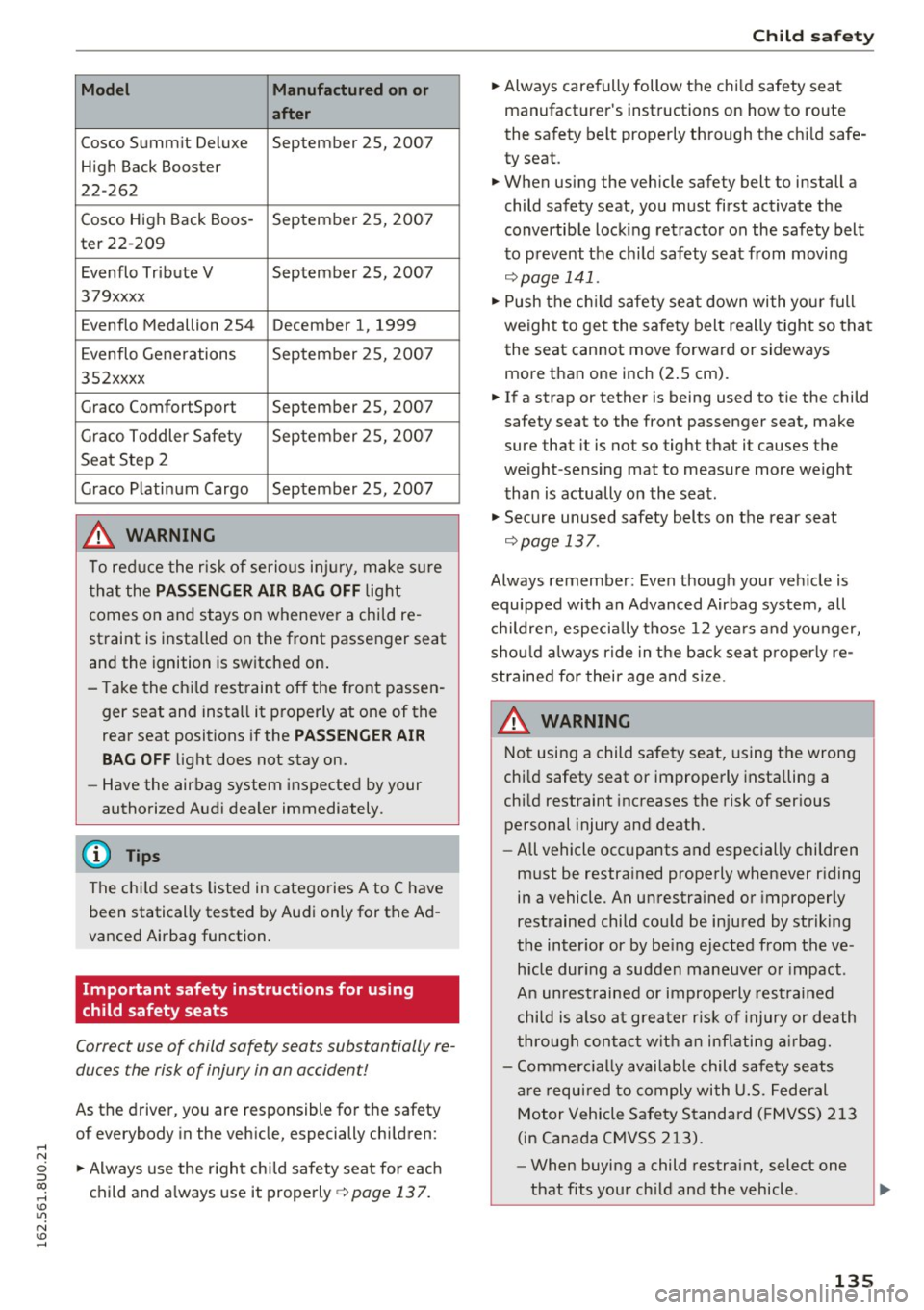
Model Manufactured on or
after
Cosco Summit Deluxe September 25, 2007
High Back Booster
22-262
Cosco High Back Boos -
September 25, 200 7
ter 22-209
Evenflo Tr ibute V September 25, 2007
379xxxx
Evenflo Medallion 254 December 1, 1999
Evenflo Generations September 25, 2007
352xxxx
Graco ComfortSport September 25, 2007
Graco Toddler Safety September 25, 2007
Seat Step 2
Graco Platinum Cargo September 25, 2007
.&_ WARNING
To reduce the risk of serious inju ry, make sure
that the
P ASS ENGER AIR BAG OFF light
comes on and stays on whenever a child re
straint is installed on the front passenger seat
and the ignition is switched on.
- Take the child restraint off the front passen
ger seat and install it properly at one of the
rear seat positions if the
P A SSEN GER AIR
BAG OFF
light does not stay on.
- Have the airbag system inspected by your
authorized Audi dealer immediately.
(D Tips
The chi ld seats listed in categories A to C have
been statically tested by Audi only for the Ad
vanced Airbag function.
Important safety instructions for using
child safety seats
Correct use of child safety seats substantially re
duces the risk of injury in an accident!
As the driver, you are responsible for the safety
of everybody in the veh icle, especially chi ldren:
.,. Always use the r ight child safety seat for each
child and a lways use it properly
q page 137.
Child safety
.,. Always carefully follow the chi ld safety seat
manufacturer's instructions on how to route
the safety belt properly through the ch ild safe
ty seat.
.,. When using the vehicle safety belt to install a
child safety seat, you must first activate the
convertible locking retractor on the safety belt
to prevent the chi ld safety seat from moving
q page 141.
.,. Push the ch ild safety seat down with your full
weight to get the safety belt really tight so that the seat cannot move forward or sideways
more than one inch (2.5 cm).
.,. If a strap or tether is being used to tie the child
safety seat to the front passenger seat, make
sure that it is not so tight that it causes the
weight -sensing mat to measure more weight
than is actually on the seat .
.,. Secure unused safety belts on the rear seat
q page 137.
Always remember: Even though your veh icle is
equipped with an Advanced Airbag system, all
ch ildren, especia lly those 12 years and younger,
sho uld a lways ride in the back seat proper ly re·
strained for their age and s ize.
.&_ WARNING
=
Not using a child safety seat, using the wrong
chi ld safety seat or improperly insta lling a
chi ld restraint increases the risk of serious
personal injury and death.
- All vehicle occupants and especially children
must be restrained properly whenever riding
in a vehicle. An unrestra ined or improperly
restrained child could be injured by striking
the inter ior or by be ing ejected from the ve
h icle dur ing a sudden maneuve r or impact .
An unrest rained or imprope rly restrained
child is a lso at greater r isk of injury or death
through contact w ith an inflating a irbag.
- Commerc ially availab le child safety seats
are required to comply with U.S. Federal
Motor Vehicle Safety Standard (FMVSS) 213
(in Canada CMVSS 213).
- When buying a child restra int, select one
that fits your ch ild and the vehicle.
135
Page 138 of 252
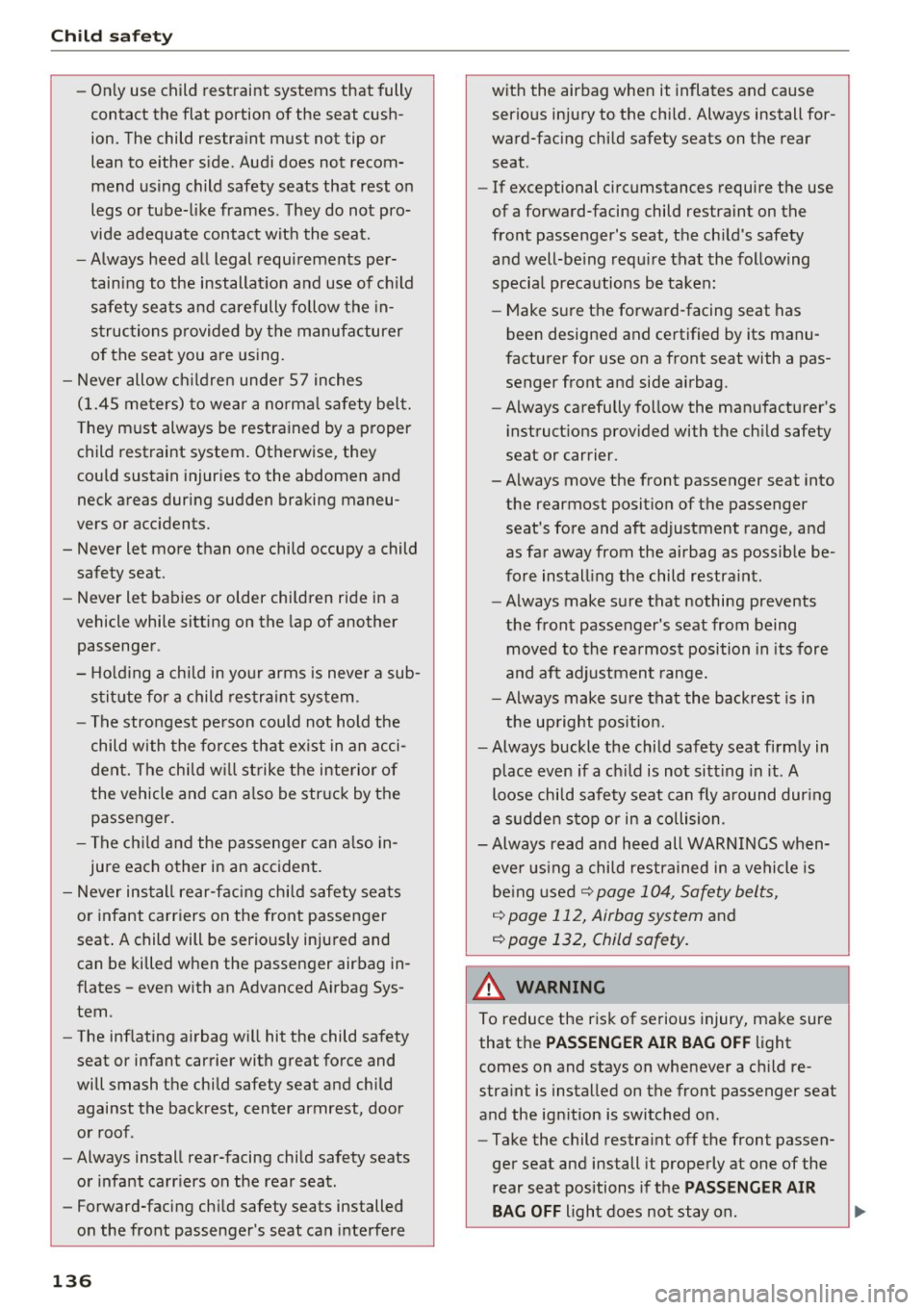
Child safety
-Only use child restraint systems that fully
contact the flat portion of the seat cush
ion. The child restraint must not tip or
lean to either side . Audi does not recom
mend using child safety seats that rest on
legs or tube-like frames. They do not pro
vide adequate contact with the seat.
-Always heed all legal requirements per
taining to the installation and use of child
safety seats and carefully follow the in
structions provided by the manufacturer
of the seat you are using.
- Never allow children under 57 inches
(1.45 meters) to wear a normal safety belt.
They must always be restrained by a proper
child restraint system. Otherwise, they
could sustain injuries to the abdomen and
neck areas during sudden braking maneu
vers or accidents.
- Never let more than one child occupy a child safety seat.
- Never let babies or older children ride in a
vehicle while sitting on the lap of another
passenger.
- Holding a child in your arms is never a sub
stitute for a child restraint system.
- The strongest person could not hold the
child with the forces that exist in an acci
dent. The child will strike the interior of
the vehicle and can also be struck by the
passenger.
- The child and the passenger can also in
jure each other in an accident.
- Never install rear-facing child safety seats
or infant carriers on the front passenger
seat. A child will be seriously injured and can be killed when the passenger airbag in
flates -even with an Advanced Airbag Sys
tem .
- The inflating airbag will hit the child safety
seat or infant carrier with great force and
will smash the child safety seat and child
against the backrest, center armrest, door
or roof.
- Always install rear-facing child safety seats
or infant carriers on the rear seat .
- Forward-facing child safety seats installed
on the front passenger's seat can interfere
136
with the airbag when it inflates and cause
serious injury to the child. Always install for
ward-facing child safety seats on the rear seat .
- If exceptional circumstances require the use
of a forward-facing child restraint on the
front passenger's seat, the child's safety and well-being require that the following
special precautions be taken:
- Make sure the forward-facing seat has
been designed and certified by its manu
facturer for use on a front seat with a pas
senger front and side airbag.
- Always carefully follow the manufacturer's
instructions provided with the child safety
seat or carrier.
-Always move the front passenger seat into
the rearmost position of the passenger
seat's fore and aft adjustment range, and
as far away from the airbag as possible be
fore installing the child restraint.
- Always make sure that nothing prevents
the front passenger's seat from being
moved to the rearmost position in its fore
and aft adjustment range.
-Always make sure that the backrest is in
the upright position.
-Always buckle the child safety seat firmly in
place even if a child is not sitting in it. A
loose child safety seat can fly around during
a sudden stop or in a collision.
-Always read and heed all WARNINGS when
ever using a child restrained in a vehicle is
being used~
page 104, Safety belts,
~ page 112, Airbag system and
~ page 132, Child safety.
_&. WARNING
To reduce the risk of serious injury, make sure
that the
PASSENGER AIR BAG OFF light
comes on and stays on whenever a child re
straint is installed on the front passenger seat
and the ignition is switched on.
- Take the child restraint off the front passen
ger seat and install it properly at one of the rear seat positions if the
PASSENGER AIR
BAG OFF
light does not stay on. ~
Page 139 of 252
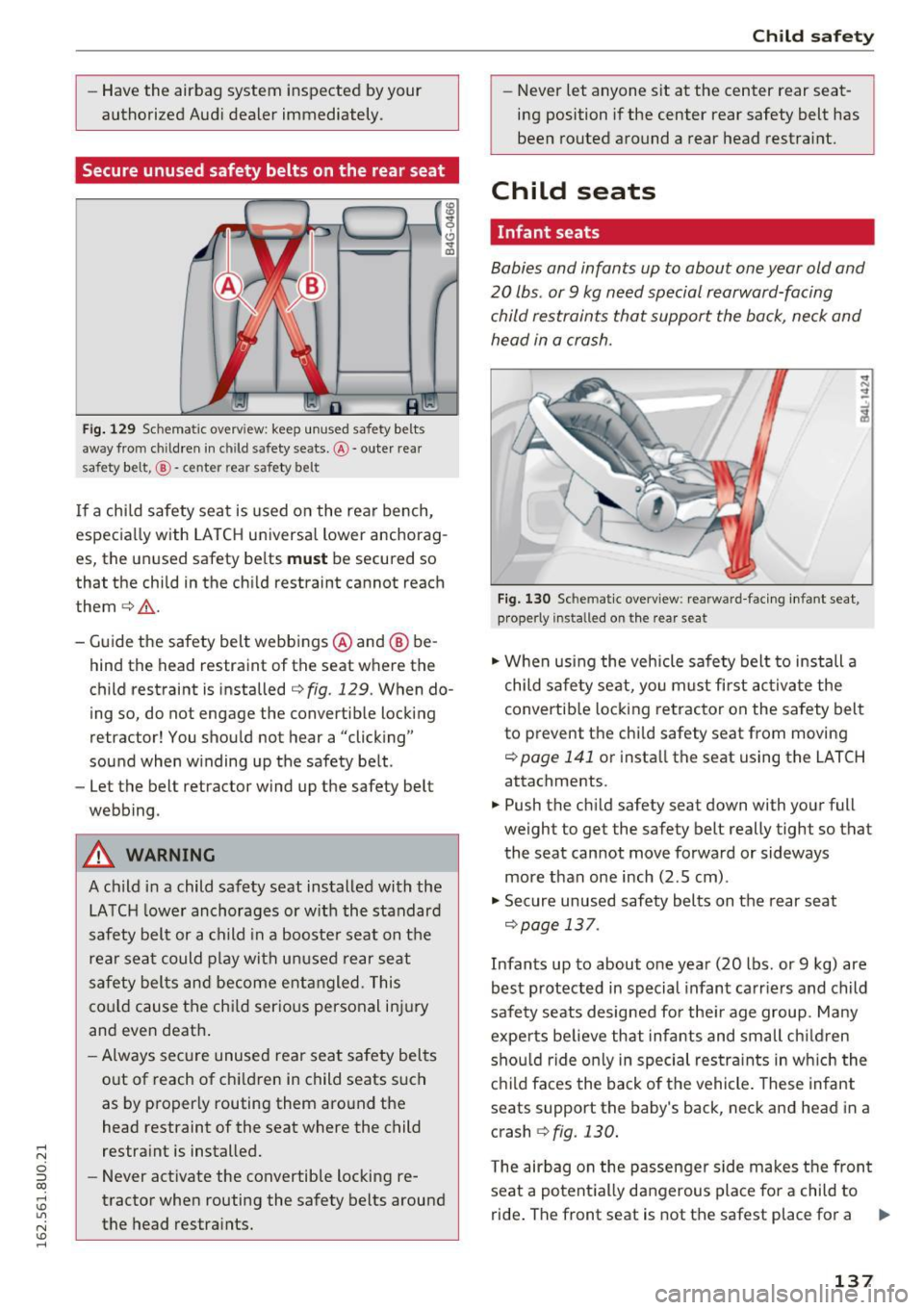
.... N
c:i ::J CX)
.... I.Cl U"I
N I.Cl ......
-Have the airbag system inspecte d by y our
authorized Aud i dealer immediately .
Secure unused safety belts on the rear seat
Fig. 129 Schematic overview: keep unused safety belts
away from c hildren in child safety seats.@-oute r rea r
safety belt, ® · center rear safety belt
If a chi ld safety seat is used o n the rear bench,
especially with LATCH universal lower anchorag
es, the unused safety be lts
mu st be secured so
that the child in the child restraint cannot reach
them
c:> ,&. .
- Guide the safety belt webbings @and @ be
hind the head restraint of the seat where the
child restraint is installed
c:> fig. 129. When do
ing so, do not engage the convertib le locking
retractor! You should not hear a "clicking"
sound when w inding up the safety belt.
- Let the belt retractor wind up the safety belt
webbing .
A WARNING
A child in a child safety seat installed with the
LA TC H l owe r anchorages or w ith the standard
safety belt or a child in a booste r seat on the
rear sea t could play with u nused rear seat
safety belts and become enta ngled. This
co uld cause the chi ld ser io us personal i nju ry
and even death .
- Always secure unused rear seat safety belts
o ut of reach of chi ldren in child seats such
as by proper ly routing them around t he
head restraint of the seat where the child
restra int is installed .
- Never activate the convertible locking re
tractor when routing the safety belts around
the head restra ints.
Ch ild sa fety
- Never let anyone sit at the center rear seat
ing position if the center rear safety belt has
been routed around a rear head restraint.
Child seats
Infant seats
Babies and infants up to about one year old and
20 lbs . or
9 kg need special rearward-facing
child restraints that support the back, neck and
head in a crash.
F ig . 1 30 Sc hema tic overv iew : re arwa rd-facing in fan t seat,
p roperly installed on the rear seat
"'When using the vehicle safety belt to install a
child safe ty seat, yo u m ust first ac tivate the
convertib le locking retrac tor on the safety belt
to p revent the chi ld safety seat from moving
c:> page 141 or insta ll the seat using the LATCH
attachments.
"' Push the ch ild safety seat down with your full
weight to get the safety belt really tight so that
the seat cannot move forward or sideways
more than one inch (2.5 cm) .
"' Secure unused safety belts on the rear seat
r=;,page 137.
Infants up to about one year (20 lbs. or 9 kg) are
best protected in special infant carriers and child
safety seats designed for the ir age group. Ma ny
expe rts be lieve that infa nts and small ch ild ren
shou ld ride only in special restra ints in wh ich the
ch ild faces the back of the vehicle . These infant
seats support the baby's back , neck and head in a
crash
c:> fig . 130.
The airbag on the passenger side makes the fron t
seat a potent ially dangerous place for a child to
ride . The front seat is not the safest place for a
Ill>
137
Page 140 of 252
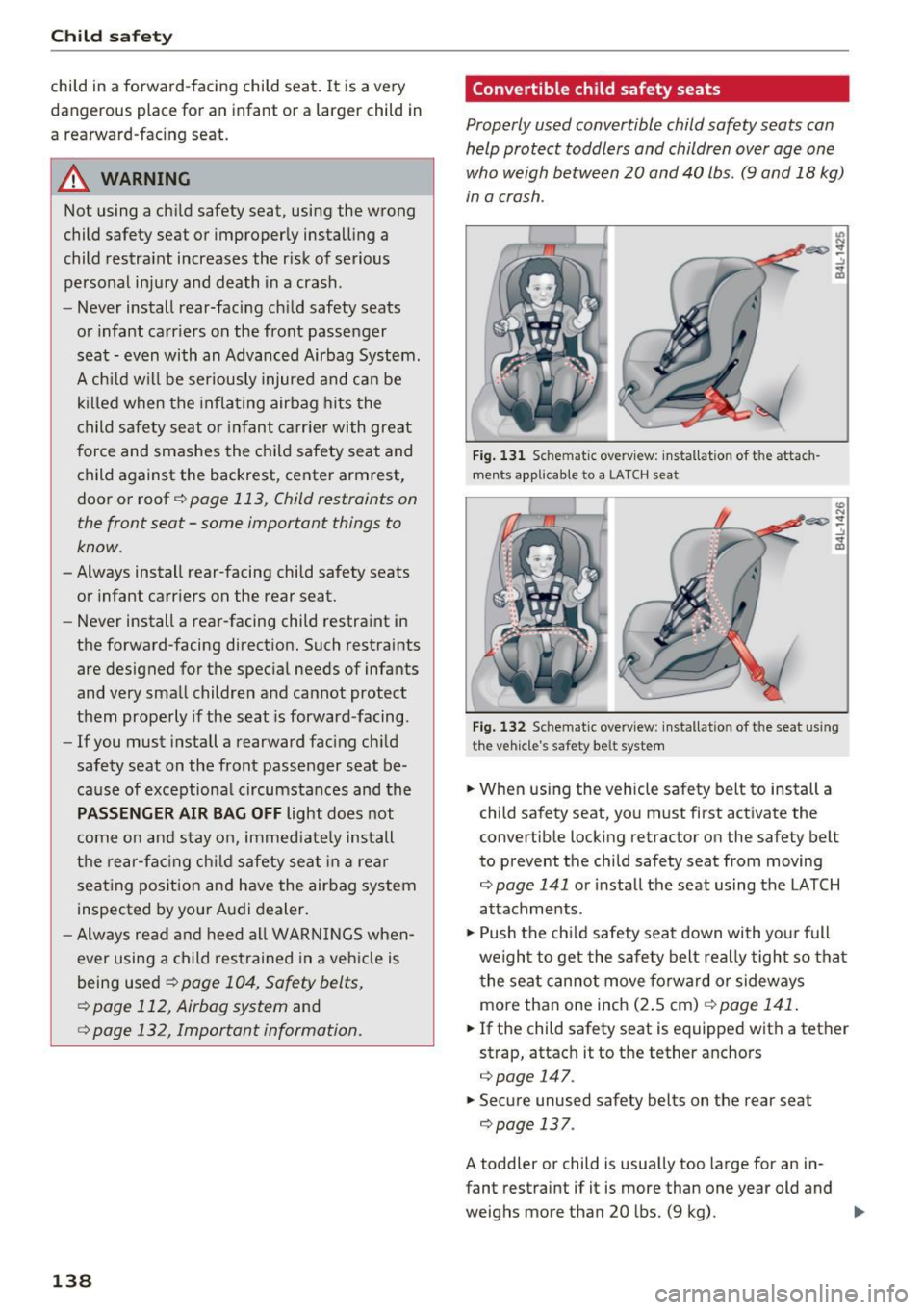
Child safety
child in a forward -facing child seat. It is a very
dangerous place for an infant or a larger child in
a rearward-facing seat.
A WARNING
Not using a child safety seat, using the wrong
child safety seat or improper ly installing a
child restra int increases the r isk of serious
personal injury and death in a crash .
- Never install rear-facing child safety seats
or infant carr iers on the front passenger
seat -even with an Advanced Airbag System.
A ch ild w ill be seriously injured and ca n be
k illed when the infla ting airbag hits the
child safety seat or infant carr ier with great
force and smashes the child safety seat and
child against the backrest, center armrest,
door or roof
Q page 113, Child restraints on
the front seat- some important things to
know .
-Always install rear-facing child safety seats
or infant carr iers on the rear seat.
- Never install a rear-facing child restraint in
the forward-facing direction. Such restraints are designed for the spec ial needs of infants
and very small children and cannot protect
them properly if the seat is forward -facing .
- If you must install a rearward fac ing ch ild
safety seat on the front passenger seat be
ca use of exceptional circumstances and the
PASSENGER AIR BAG OFF light does not
c ome on and stay on, immed iate ly install
the rear-fa cing ch ild safety seat in a rear
seating pos ition and have the airbag system
inspected by your Audi dealer.
- Always read a nd heed all WARN INGS when
ever using a child restrained in a vehicle is
being used¢
page 104, Safety belts,
¢ page 112, Airbag system
and
¢ page 132 , Important information.
138
Convertible child safety seats
Properly used convertible child safety seats can
help protect toddlers and children over age one
who weigh between 20 and 40 lbs. (9 and 18 kg)
in a crash .
Fig. 131 Sc hem at ic overv iew : installat ion of t he attach
ment s applicable to a LA TCH seat
Fig. 132 Sc hemat ic overv iew : installat ion of t he seat using
the vehicle's sa fety bel t system
.. When using the vehicle safety belt to install a
child safety seat, you must first activate the
convertib le locking retractor on the safety belt
to prevent the child safety seat from moving
¢page 141 or install the seat using the LATCH
attachments .
.. Push the chi ld safety seat down wi th your full
we igh t to get the safe ty belt really tight so that
the seat cannot move forward or sideways
more than one inch (2 .S cm)
<=> page 141 .
.. If the child safety seat is equipped with a tether
strap, attach it to the tether anchors
¢ page 147 .
.. Secure unused safety belts on the rear seat
Q page 137.
A toddler or child is usually too large for an in
fant restraint if it is more than one year old and
weighs more than 20 lbs. (9 kg).
ll>-